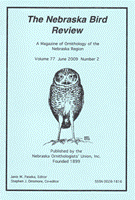Nebraska Ornithologists' Union

Nebraska Bird Review
Date of this Version
12-2021
Document Type
Article
Citation
The Nebraska Bird Review, Volume 89 Number 4, December 2021, pp. 150-172
Abstract
INTRODUCTION Recent years have seen increasing reports of birds lingering quite late, and this fall was no exception. Notable groups exhibiting tardy departures were shorebirds and vireos. Tardy shorebirds were record late Solitary Sandpipers, near-record late Dunlin, and late Long-billed Curlew, Ruddy Turnstone, Least and Semipalmated Sandpipers, Long-billed Dowitcher, and Wilson’s Phalarope. Among the vireos, all regular species were at least tardy; record late was a Red-eyed Vireo, a Warbling Vireo was record late for the Panhandle, and a Blue-headed Vireo was second latest on record. Record late was a Barn Swallow, and a Mountain Bluebird was record late in the Panhandle. An interesting project by Sharla Meester and Dave Stage recording late Eastern Whip-poor-wills in Douglas Co yielded Oct records, the first for the state. On the other hand, there were no fewer than five record early fall dates. A Herring Gull was record early for an adult, while record early were a Red-tailed (Harlan’s) Hawk, a Northern Shrike (by one day), a Yellow-rumped (Myrtle) Warbler, and a Townsend’s Warbler. Each fall brings a set of high counts; there were several this fall for diverse species, including records for Cackling Goose of 31,000, Greater Scaup at 164, Stilt Sandpiper at 1300, and Yellow-headed Blackbird at 4800. Record fall counts were Lesser Yellowlegs at 800, Red-necked Phalarope at 155, Blue Jay at 200, Violet-Green Swallow at 80, and, oddly, 5 Black-throated Blue Warblers. Other good counts were 93 Whooping Cranes including 53 in one group, 28 Burrowing Owls, and 40 Smith’s Longspurs. Both Snowy Owl and Common Redpoll appeared in numbers suggesting more to come during the winter. Eastern birds unexpectedly westerly were rare Panhandle records for Buffbreasted Sandpiper, Short-billed Dowitcher, Rusty Blackbird and Scarlet Tanager; a Northern Parula was westerly and quite late in Dundy Co. Conversely, western birds east were a Yellow-rumped (Audubon’s) Warbler, 5th for the east in fall, and a Western Tanager, 4th for fall in the east. Quite interesting were a few reports of breeding that carried over into Aug. Mississippi Kites nested in McCook, Red Willow Co, for an apparent first confirmed record there and in Lincoln, Lancaster Co, for a second record there. An intriguing possibility was Cordilleran Flycatcher breeding at Fort Niobrara NWR, Cherry Co. Tracking numbers of Pygmy Nuthatch at NNF Bessey, Thomas Co, yielded an excellent total there as the population is doing well since first establishing in 2014. Also a surprise at Fort Niobrara NWR were nesting Louisiana Waterthrushes at two locations, possibly three.
A quick note on a couple of exotics: Mute Swan occurs as a wild bird, but with only two records so far, and so the provenance of a couple in northeastern Nebraska was of great interest (see article on page 181 of this issue). Egyptian Goose is being reported more often; it may establish as a generally unwanted breeder. And now the rarities. Probably the most surprising was a Black-throated Gray Warbler easterly in Knox Co, while maybe the coolest was a Gyrfalcon photographed in extreme northeastern Cherry Co. Additional “good birds” were Gray Flycatcher, Vermilion Flycatcher, Common Raven, and Golden-crowned Sparrow. Finally, thanks to the 140 birders who took time to report their sightings; these reports make a summary like this possible.
Included in
Ornithology Commons, Population Biology Commons, Poultry or Avian Science Commons, Zoology Commons


Comments
Published by the Nebraska Ornithologists’ Union, Inc.